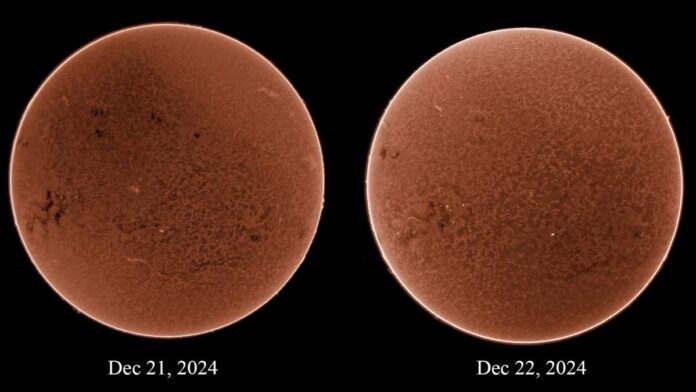
Photographs of the sun taken on different days by Kiran Mohan and Fahd Bin Abdul Hasis using special equipment.
| Photo Credit: Special Arrangement
Two astrophotography enthusiasts from the district have captured some stunning images of the sun which is now in the solar maximum phase of its periodic cycle.
Kiran Mohan and Fahd Bin Abdul Hasis snapped the photos over the past several days using a dedicated solar telescope for observing the solar features in the 656.28 nanometre wavelength with a very small bandwidth.
Both of them are scientists at the Liquid Propulsion Systems Centre (LPSC), an Indian Space Research Organisation (ISRO) facility in Thiruvananthapuram. They have been observing the sun from Enikkara, where they live.
Solar activity peaks
“The sun has an 11-year periodic cycle wherein solar activity peaks around a point called the solar maxima. During this time there will be a lot of solar flares, coronal mass ejections and sun spots which are visible on the sun. We recently started photographing all these phenomena,” Mr. Kiran Mohan said.
Keen astrophotographers, the duo had snapped photographs of celestial events, including ‘visiting’ comets such as the ‘green comet’ C/2022 E3 (ZTF) last year and the long-period comet C/2023 A3 (Tsuchinshan–ATLAS) which was visible earlier this year.
Equipment
But studying the blazing hot sun requires different techniques. For observing and photographing the star, they use a a Daystar Solar Scout 60 mm DS h-alpha telescope, an iOptron SkyGuider Pro tracker and a Nikon Z6ii camera. “Short video frames at 60 frames per second and 15-second duration are captured and processed to capture the features of the sun in the h-alpha wavelength (656.28 nanometre),” Mr. Fahd said.
In mid-October, the National Aeronautics and Space Administration, the National Oceanic and Atmospheric Agency of the United States, and the Solar Cycle Prediction Panel had announced that the sun had entered its solar maximum phase.
Published – December 23, 2024 07:05 pm IST
